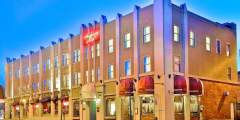What elements make a great city? When Anchorage’s forefathers landed at Ship Creek in 1915, those elements were people, education, jobs, culture, capital investments, productivity and growth, food production and subsistence, wildlife and natural beauty. So these pioneers set out to make them all a reality.
In a place as remote as Alaska, though, they knew a great city wouldn’t happen without transportation. The grand dream was to build an interconnected railway across a small portion of Alaska’s territory, but no one really knew if it was feasible. They had done their fieldwork and tried to find the best possible route—but they needed men, materials, food, housing, and private investment. Men brought their families, which meant the need for education, culture, and recreation—and, of course, housing and local transportation. So these hardscrabble pioneers pushed dirt, rock, mud, and snow; plotted and sold land; set up government facilities; and tamed the wilderness in the quickest way possible to move Alaska forward.
Four distinct neighborhoods arose to meet the call for housing and land management offices, as well as school, library, and museum facilities. Some of the funds for this came from private investment, but in this highly unique and faraway place, the Federal government put significant resources into building the first cottages and first school, as well as providing money for power generation, communications, water, and sewer systems. It was an important investment. After all, this bustling boomtown had to bring coal, gold, and other natural resources to the lower 48. The citizens of Anchorage met that challenge.
They Started at Ship Creek
Stand at the Ship Creek boat launch and try to imagine the hopes and dreams that landed there with the people. The Dena’ina came first by water and across the land to hunt, gather, catch salmon and beluga, trade for wares, visit with friends and family, and to celebrate the many ceremonies held to thank their creator for this abundance.
Ship Creek was and is the epicenter of our fair city—an essential spot for both our Alaska Native Peoples and the Anchorage settlers. Home to fish camps and the First Salmon Ceremony by the Dena’ina, Ship Creek was also the first campsite of Jack and Nellie Brown. Jack had been sent here to manage the newly designated Chugach National Forest and arrived in 1912. Ship Creek became the major focal point for the new city, as well as the entire Territory of Alaska.
Today, Ship Creek is easily accessible to all, featuring hiking trails and fishing spots. Take a rod and reel and imagine the Dena’ina as they pitched their spring campsites to harvest the early run of King Salmon, hunt beluga whales, and commune with black and brown bears. The tradition is kept alive today with the annual Ship Creek Salmon Derby, a popular community event held each year.
Ship Creek was also home to a Tent City established in 1915, when Boomers arrived from all over the world amidst rumors of railroad employment. Russians, Swedes, and people from all over North and South American camped and worked alongside the Dena’ina to set up the railroad infrastructure, including the port and the railroad itself. You’ll find interpretive information about this along the Ship Creek Trail.
For more information: Historic Preservation Plan for Anchorage’s Four Original Neighborhoods
Did you know that all of these neighborhoods have structures built in the early 1900s and listed on the National Register of Historic Places? Take a walk or drive around town and see if you can find how many of them were built in 1915. Many were celebrated during the Anchorage 2015 Centennial.
Show Map
Neighborhoods
Today, this unique, geographically isolated area is accessible only by bridge. But it’s worth the effort: you can stand on the very spot where Anchorage’s first neighborhood began, at the corner of Delaney and West Harvard streets. From here you can see the Brown’s Point Cottages to the west, now listed on the National Register of Historic Places. And walk north along West Harvard Street to see what remains of the old cottages.
Downtown’s convenient grid pattern was set up at the same time that construction started on the Government Hill neighborhood. And in 1915, downtown’s plots of land were auctioned off to the highest bidders. Many of the buildings from that era not only still stand, but are still named after some of the city’s founding fathers, reminding us of the sacrifices they made to give a future to their budding city.
This neighborhood was created in the late 1930’s and early 1940’s in response to the wartime build-up and ongoing need for housing. To encourage farming, many lots were larger here than in Downtown or Government Hill.
Fairview was built beyond the city boundary and became an established community after World War II. Yet the area maintained a fierce independence streak. Those who lived here hoped to avoid bureaucratic oversight and taxation, and even had their own public utility district. It was the only neighborhood that African-Americans could buy property in. And when Anchorage tried to annex the area in the 1950s, locals fought back, in a lawsuit that ...more



